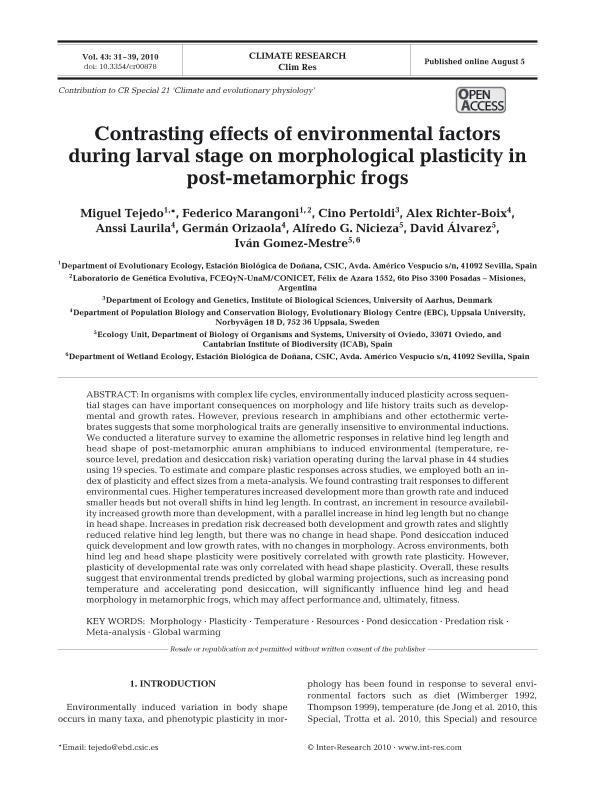Mostrar el registro sencillo del ítem
dc.contributor.author
Tejedo, Miguel
dc.contributor.author
Marangoni, Federico

dc.contributor.author
Pertoldi, Cino
dc.contributor.author
Richter-Boix, Alex
dc.contributor.author
Laurila, Anssi
dc.contributor.author
Orizaola, Germán
dc.contributor.author
Nicieza, Alfredo G.
dc.contributor.author
Álvarez, David
dc.contributor.author
Gomez Mestre, Iván
dc.date.available
2018-09-05T20:35:41Z
dc.date.issued
2010-08-05
dc.identifier.citation
Tejedo, Miguel; Marangoni, Federico; Pertoldi, Cino; Richter-Boix, Alex; Laurila, Anssi; et al.; Contrasting effects of environmental factors during larval stage on morphological plasticity in post-metamorphic frogs; Inter-Research; Climate Research; 43; 1-2; 5-8-2010; 31-39
dc.identifier.issn
0936-577X
dc.identifier.uri
http://hdl.handle.net/11336/58467
dc.description.abstract
In organisms with complex life cycles, environmentally induced plasticity across sequential stages can have important consequences on morphology and life history traits such as developmental and growth rates. However, previous research in amphibians and other ectothermic vertebrates suggests that some morphological traits are generally insensitive to environmental inductions. We conducted a literature survey to examine the allometric responses in relative hind leg length and head shape of post-metamorphic anuran amphibians to induced environmental (temperature, resource level, predation and desiccation risk) variation operating during the larval phase in 44 studies using 19 species. To estimate and compare plastic responses across studies, we employed both an index of plasticity and effect sizes from a meta-analysis. We found contrasting trait responses to different environmental cues. Higher temperatures increased development more than growth rate and induced smaller heads but not overall shifts in hind leg length. In contrast, an increment in resource availability increased growth more than development, with a parallel increase in hind leg length but no change in head shape. Increases in predation risk decreased both development and growth rates and slightly reduced relative hind leg length, but there was no change in head shape. Pond desiccation induced quick development and low growth rates, with no changes in morphology. Across environments, both hind leg and head shape plasticity were positively correlated with growth rate plasticity. However, plasticity of developmental rate was only correlated with head shape plasticity. Overall, these results suggest that environmental trends predicted by global warming projections, such as increasing pond temperature and accelerating pond desiccation, will significantly influence hind leg and head morphology in metamorphic frogs, which may affect performance and, ultimately, fitness.
dc.format
application/pdf
dc.language.iso
eng
dc.publisher
Inter-Research

dc.rights
info:eu-repo/semantics/openAccess
dc.rights.uri
https://creativecommons.org/licenses/by-nc-sa/2.5/ar/
dc.subject
Global Warming
dc.subject
Meta-Analysis
dc.subject
Morphology
dc.subject
Plasticity
dc.subject
Pond Desiccation
dc.subject
Predation Risk
dc.subject
Resources
dc.subject
Temperature
dc.subject.classification
Otras Ciencias Biológicas

dc.subject.classification
Ciencias Biológicas

dc.subject.classification
CIENCIAS NATURALES Y EXACTAS

dc.title
Contrasting effects of environmental factors during larval stage on morphological plasticity in post-metamorphic frogs
dc.type
info:eu-repo/semantics/article
dc.type
info:ar-repo/semantics/artículo
dc.type
info:eu-repo/semantics/publishedVersion
dc.date.updated
2018-08-17T19:00:42Z
dc.journal.volume
43
dc.journal.number
1-2
dc.journal.pagination
31-39
dc.journal.pais
Alemania

dc.journal.ciudad
Oldendorf/Luhe
dc.description.fil
Fil: Tejedo, Miguel. Consejo Superior de Investigaciones Científicas. Estación Biológica de Doñana; España
dc.description.fil
Fil: Marangoni, Federico. Consejo Superior de Investigaciones Científicas. Estación Biológica de Doñana; España. Consejo Nacional de Investigaciones Científicas y Técnicas. Centro Científico Tecnológico Conicet - Nordeste. Instituto de Materiales de Misiones. Universidad Nacional de Misiones. Facultad de Ciencias Exactas Químicas y Naturales. Instituto de Materiales de Misiones; Argentina
dc.description.fil
Fil: Pertoldi, Cino. University Aarhus; Dinamarca
dc.description.fil
Fil: Richter-Boix, Alex. Uppsala University; Suecia
dc.description.fil
Fil: Laurila, Anssi. Uppsala University; Suecia
dc.description.fil
Fil: Orizaola, Germán. Uppsala University; Suecia
dc.description.fil
Fil: Nicieza, Alfredo G.. Universidad de Oviedo; España
dc.description.fil
Fil: Álvarez, David. Universidad de Oviedo; España
dc.description.fil
Fil: Gomez Mestre, Iván. Universidad de Oviedo; España. Consejo Superior de Investigaciones Científicas. Estación Biológica de Doñana; España
dc.journal.title
Climate Research

dc.relation.alternativeid
info:eu-repo/semantics/altIdentifier/doi/http://dx.doi.org/10.3354/cr00878
dc.relation.alternativeid
info:eu-repo/semantics/altIdentifier/url/https://www.int-res.com/abstracts/cr/v43/n1-2/p31-39/
Archivos asociados
